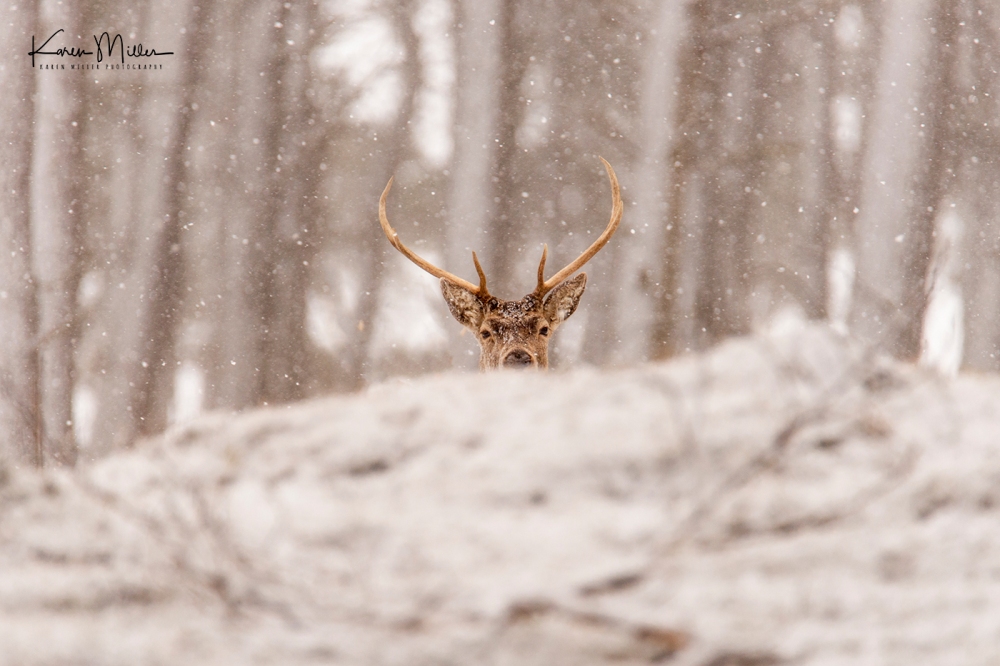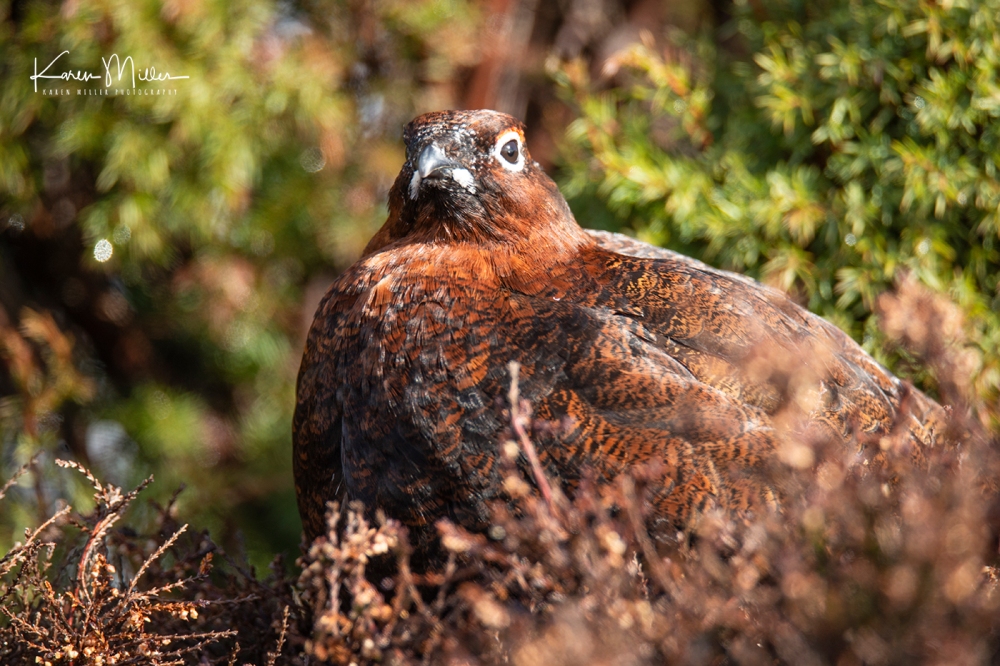Finally after a few weeks of unseasonably mild (and windy, oh so windy) weather, winter returned for a brief spell to the Scottish Highlands in early March much to my delight. Although working during the week I was able to take advantage of the conditions for a couple of weekends, although it proved more than a little challenging!
Sunday 10th of March I headed to the mountain hares bright and early. The walk up the hill was ok, and the winds weren’t too bad. The forecast was for conditions to deteriorate at lunch time, but “weather” arrived earlier than expected and it wasn’t long before swirling winds and snow made an unwelcome appearance. Here I am in a rare selfie video!
The hares were pretty active or distant and after photographing a couple I decided the best thing to do was find a sheltered spot and hope that some would run towards or near me.



I didn’t have much luck so deciding to move on I turned around only to discover a hare had settled down a short distance away. (You should always check all around you before moving as this often happens).


I crept closer, possibly a little too close as I was trying to find cover from the elements, and the hare moved down the hill a little bit which was a shame as this was a nice spot with few distractions. I managed a images before it settled down again thinking that it would travel too far for me to follow.



Fortunately it quickly found a new spot not too far away and hunkered down, I shuffled down the hill and found a gap between two mounds to shelter in. It was miserable. Really miserable. I couldn’t keep the snow off the camera lens or body, even with a waterproof cover. My outer layers were soaked and I was gradually disappearing under the falling snow. The hare hunkered down, and I watched as it turned into a snowball. Within 30 minutes of first coming across it, the hare had virtually vanished, with only its eyes and nose visible – had I looked for it now I’d never have seen it. For hares these aren’t difficult conditions, they are much more suited to weather like this than to hot or wet days, the snow acts as insulation. Not great for us humans though!



It was really unpleasant and I questioned my sanity especially as visibility was now very poor and the wind increasingly strong.
So after a mere two hours I called it a day and walked down the hill with fellow photographer Ian Herd. I am pleased with the images I managed though as I didn’t have any quite like these!
Fortunately, I already had other plans for the afternoon. In March 2018 I’d seen images of red deer stags standing in the snow in a forest. Transpired that they were taken on the Alvie Estate just outside of Aviemore. This estate offers a number of activities from zip wires to a red squirrel hide and the opportunity, for a fee, to photograph the stags as they are fed. It’s great to have an estate using wildlife in a good way. I’ve never really managed any decent red deer images, except for a couple that make me smile which I took when at Aigas, and given that snow was forecast I thought this might be a good time to check out the estate. I hadn’t expected it to be quite so snowy though! This was a good thing mind you as it encouraged all the stags to come down off the hill to feed, in fact they were all awaiting our arrival. The gamekeeper held off putting out the food for a while so that I could get some photographs as they patiently waited. I discovered to my concern that my D500’s viewfinder was filled with condensation (it was already sick – it wouldn’t turn off) but I had brought the D610 too, so was able to proceed – always good to have a contingency plan! The snow was falling and the only challenging thing was trying to single out stags to photograph, as they were so often gate-crashed by other deer. Definitely some christmas card potential here! Great to see the animals close up, such majestic beasts.





I fully expected Sunday to be my final opportunity for winter weather photography, but come the following Saturday snow was again falling from the sky – too much snow really! I’d offered to take a friend, Billy McCourt, up to the hares, otherwise, having seen the forecast I don’t think I’d have gone near the hill that day. On the plus side there was no wind – amazing! So much snow had fallen overnight, and was still falling that the walk up the hill and, more especially the hill itself, were hard going. The hares were full of the joys of life, perfect conditions for them and were very mobile, bounding about all over the place and impossible to approach, especially as we were struggling to walk. I fell down so many holes, even although I was prodding the ground in front of me with my monopod. Insane!

Sadly we never made it close to any animal, although I do have some wide-angle images I like.




Lots of red grouse on the hill as well as more feral goats than I’ve seen at any point this year so far. It was still early, but we were worried about the drive back along the untreated road, although actually it was better on the return journey! Everywhere looked gorgeous, a proper winter wonderland with tree branches laden with snow and lots still falling from the sky. I love this kind of day… except when wading through it.
Next stop was RSPB Loch Garten in the hope that the inclement conditions had encouraged the crested tits to return to the feeders. No such luck, but I enjoyed photographing the chaffinches and siskins for a while as they squabbled over seed and perched beautifully as the snow fell around them.





Final stop was Cairngorm Mountain in the hope that the snow buntings would be in the carpark. We heard them as soon as we exited the cars. It was still snowing heavily, but the winds were light and the birds landed around us as we sat with them for 30 minutes or so before retreating to the cafe for a hot drink and chocolate brownie. They are beautiful little birds and their winter plumage of cream and brown matches the terrain perfectly. They tend to hang about at a small picnic area where there are stone walls. These are great for photography, especially when covered by snow because you can take eye-level images without lying on the ground – always a good thing! The birds are confident and at one point there was apparently one perched on the wall right behind my head.






Sunday the snow was already melting. I had managed to pull/strain my hip flexor muscles and there was no way I was going to make it up to the hares because it hurt too much to lift my leg plus I was a little upset that my D500 not only wouldn’t turn off anymore but now had a blank top LCD screen (it still works, but it’s not great…). It is supposed to be weather-sealed and I immediately dried it off and put in a sealed bag with silicon gel packs when I came off the hill, so it’s really annoying!! Anyway… I went to Lochindorb hoping that there’d be snow and visible red grouse. There was a little snow remaining, but there was also a lot of weather – blue sky would suddenly be replaced by heavy rain, sleet or snow. Very unpleasant and I was glad to be in the shelter of my car. It’s tricky spotting the grouse in brown heather at the best of times and even more so when travelling solo as I had to drive too. So I adopted the technique of stopping in every passing place and lay-by to scan the area to my side and in front. Annoyingly the first 2 grouse I found attracted another couple of cars of photographers who scared the birds off – 1 car was fine, but 3 too many. So I left them to it and went a bit further on. I found about 7 or 8 different birds along the road, some of which were in more photogenic locations than others. Nice to see though.



So that was winter. I think it’s probably over now – the hills I can see from my accommodation are gradually turning brown again. One week (of leave) left then I have to return to Glasgow. It’s been great though, and hopefully I’ll be back permanently before too long.
Gear –
All hare and Loch Garten bird images photographed with Nikon D500 and Nikkor 300mm F4 (old version).
Red deer and red grouse: Nikon D610 with Tamron 150-600mm (old version).
Snow buntings Nikon D610 and Nikkor 300mm F4.
Tripod used for Loch Garten and some of the red deer images, otherwise hand-held (or rested on snow/knee/heather/car window).
Videos Samsung S7


Hello Karen! Loved reading your illuminating description of photography in these difficult conditions …. and seeing more of your stunning photographs. Some food for thought for me for next winter with mountain hares in particular when I hope to spend some time around Cairngorms. Interesting reading information on your use of bodies and lenses…. for wildlife I’m primarily using D800/D850 with Nikkor 300 f4 pf and just recently the Nikkor 500 f5.6 pf and considering a D500 to replace D800 for more flexibility. These pf lenses balance perfectly and very easy to carry around for hours. Hope your D500 is back to normal from the condensation! Thanks for sharing your experiences and I’ll read more later.
LikeLike
Thanks John! The D500 is a brilliant camera, well worth investing in – mine is sadly still sick (doesn’t turn off, top LCD screen is blank and I think the shutter may be on the way out…) but at least it worked for the duration of my trip, I’d have been lost without it! Fortunately I do have camera insurance.
LikeLike
Not good about the camera Karen, but great that you are covered! Just back from long week-end trip away and look forward to reading your holiday week blog tomorrow at some stage.
LikeLike
Thanks John!
LikeLike
Great post. I was checking constantly this blog and I am impressed!
Very helpful information specifically the last part 🙂 I care for such
info much. I was seeking this certain information for a very long time.
Thank you and good luck.
LikeLike